|
|
| Разместил (Author): |
SergUA6  |
| Авторские права |
© http://www.radioscanner.ru |
|
|
Текст
|
Parameters of OFDM signals.
LU, LG and the “magic” coefficient k.
It is supposed that the reader is familiar with the previous articles about various aspects of analysis of OFDM signals, as terminology, the basic ideas and principles remain former. I remind, we consider OFDM signals with CP.
It is obvious, that qualitative OFDM analysis is rather not trivial and difficult task. Below we will consider the basic problems, try to prove criteria of the qualitative analysis and we mention prospects of SA development.
From numerous enough publications (including our publications) on our site , there is an opinion that an ultimate goal of analysis of OFDM signals – is getting of such parameters as speed of manipulation , quantity of frequencies, step between frequencies (frequency spacing) and modulation in channels. In general, it is certainly true.
But it is absolutely clear that at least, speed of manipulation and a step between frequencies (frequency spacing) do strongly depend on the real sampling rate. In the practical analysis, it leads to that the same signals can have absolutely different values of these parameters, because exact sampling rate of a signal/record is usually unknown.
We suggest to abstract from concrete values of these parameteres, and to concentrate efforts on the authentic, guaranteed reception of their exact relation. It deduces the task of OFDM analysis in a bit different plane, which is much closer to the truth.
Let's fresh up in memory bases of formation of OFDM signals with CP.
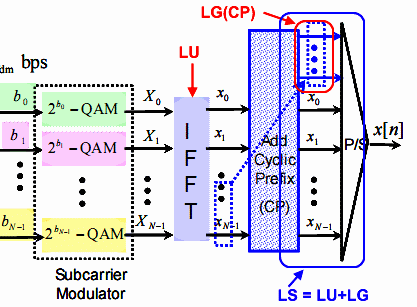
As we can see, neither clock frequency of manipulation, nor a step between frequencies (frequency spacing) do not appear anywhere evidently, because these parameters, in general, are secondary, and entirely depend on final sampling rate of OFDM formation. While such parameters as the size of IFFT block(LU) and CP length(LG), are basic and invariant to final sampling rate, and they should be an ultimate goal of analysis of OFDM signals. Please, pay attention that LU and LG have dimension of readout(counting out), for example, LU = 128, CP(LG) = 34, and general length of a symbol(LS) is equal accordingly 128+34=162 samples, no any hertz or milliseconds are present!
In practice it means that LU and LG of concrete signal are known, than it does not matter, on what sampling rate the signal was accepted or transferred. The demodulator will change this value in that way, to receive the necessary values LU and LG, and, in general, it does not play role for correct demodulation on what sampling rate it will occur/happen. Though there is nothing unusual in it, nevertheless, it is an important point, which needs to be understood well.
Let's go further and abstract from concrete values LU and LG, as they can be different but true in the same signal, and we will turn to relation of these values. Coefficient k = LG/LU is that "magic" value, which unequivocally characterizes OFDM signal with CP, and this value isn't dependent on external factors. All other parameters are secondary and can be received from this factor.
As k doesn't depend on external factors, it means that this coefficient can be received from a real signal/record of unknown OFDM, through the relation of frequency of channels spacing and speed of manipulation, where is k = (Shift/Br) - 1. I pass the mathematical substantiation, an interested persons can check up it independently, but I will give an example.
CIS-12: Standardly has step between frequencies (frequency spacing) 200 Hz, speed of manipulation 120 Hz. Parameters of formation of the signal, LU = 36, LG = 24, sampling rate of formation is 7200 Hz, then
k = LG/LU, 24/36 = 0.6(6)
k = (Shift/Br) - 1, (200/120) - 1 = 0.6(6)
Sampling rate of formation of OFDM signal, sets concrete values of clock frequency of manipulation and spacing of channels, where is
Shift = Fd/LU, in our example 7200/36 = 200 Hz
Br = Fd/LS, where LS = LU+LG, in our example 7200/(36+24) = 120 Hz
For sampling rate of formation, for instance 7400 Hz, we will receive
Shift = 205.5(5) Hz
Br = 123.3(3) Hz
Thus, both k and LU and LG remained former, that is, it is the same CIS-12 signal, fundamental relations, which take part in kernel formation haven't been changed, although according to an absolute values it looks as the other signal.
Thus, though we do abstract from concrete values, nevertheless calculation of "magic" k is based on their exact measurement. I underline, it is the extremely important, that values Shift and Br must be precise as much as possible, then we guaranteed will receive k value.
Let's look that gives us knowledge of "magic" k and why, at least we, admit it as the main task of analysis of OFDM signals with CP.
The small calculator is added in OCG program version 1.2.0.9 , for k calculation and possibility to get some basic parameters OFDM with CP. Values LU and LG are calculated by coefficient k, for the settled quantity of channels (all channels are considered, including pilots and missed tones). Parameters of signal CIS-12 are exposed/specified by default, the program deduces values LU and LG for the range from Channels to Channels*3, as further values cyclically repeat with increasing of LU and LG. Parameter LG is deduced in a fractional kind, and the affinity to an integer speaks about accuracy of result, in an ideal the number should be integer.
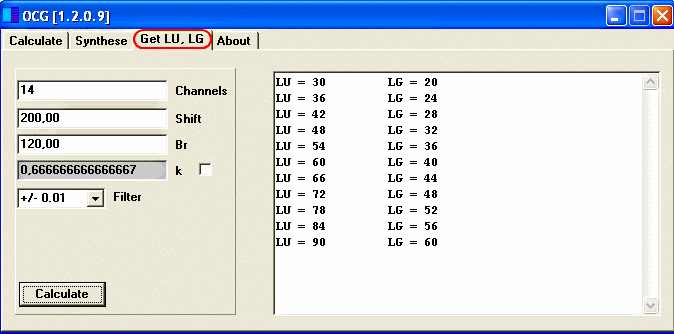
It is not difficult to find out, that CIS-12 has several "correct" LU and LG, for own "magic" k. It means, signal CIS-12 can be successfully and correctly demodulated, and-or synthesized, as at LU = 30 and LG = 20, so at LU = 36 and LG = 24, and at other values. Only sampling rate of demodulation/formation changes. It is defined as Fd = Br*LS, where LS - it is length of a symbol, which is equal in samples to LU+LG.
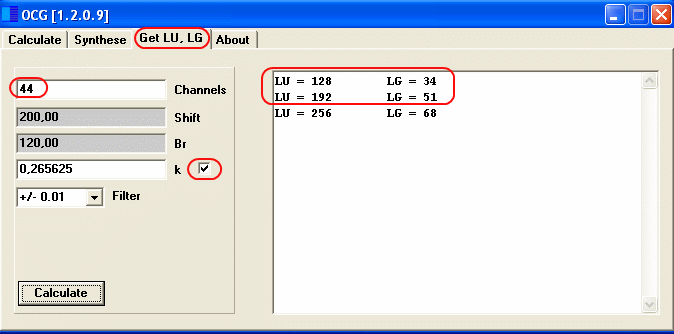
For other well known signal MIL-188-110B-39 tone "magic" k = 0.265625 And for total number of channels, which is used - 44, there are only two combinations of "correct" LU and LG, and if the first one corresponds to known sampling rate 7200 Hz, then about the second one 10800 Hz very few people knows. Certainly it is more preferable to choose lower frequency for demodulation/formation, as volumes of the general calculations are considerably reduced in this case.
The program allows to receive the basic correlations as by known/measured values Shift and Br, so only by knowing k. Only even LU values are calculated, as in practice, it is always possible to be limited by even values, though to use odd LU isn't forbidden, but except essential complication of mathematics it doesn't give any special dividends.
Nevertheless SA OFDM analyzer works with odd LU also, it was realized to increase reliability of finding of correlation triangle, as the real signals are rather far from ideal, and "superfluous" degree of freedom is only a plus.
Now we approach to very important point. What accuracy of measurements is necessary for getting of more or less authentic k? The answer is easy, as much as possible achievable. There is no even talks about any plus/minus of 1 % or 0.5 %. These are enough rough estimates.
An Example: CIS-12 with measured values Shift = 199 Hz and Br = 119 Hz, an error less than 1 % leads to impossibility of getting "correct" LU and LG values.
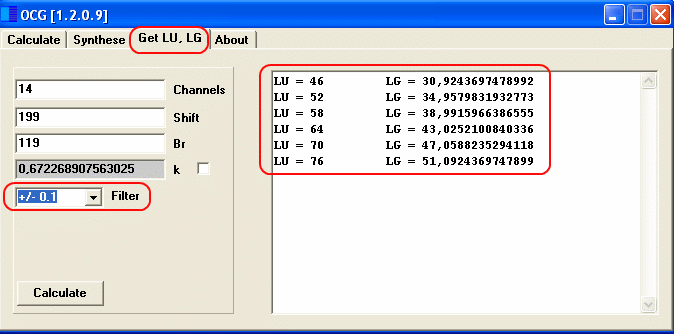
Even with rough estimate in 0.1 (Filter), "correct" LU and LG don't appear, but there are a lot of other ones, but absolutely incorrect candidates.
Exact value of one parameter and not exact of another, also does extremely negatively influences on result.
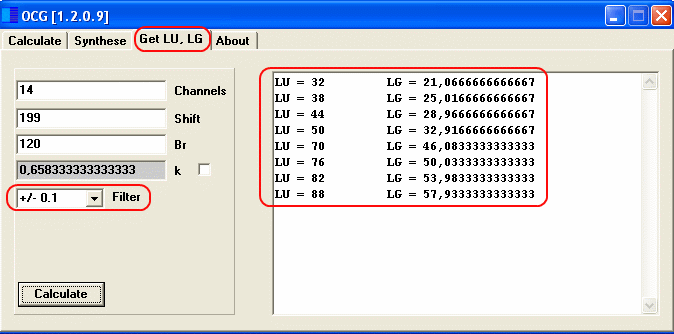
An Example: CIS-12, Shift = 199, Br = 120. A similar picture, "correct" LU and LG are replaced with mass of the “false” ones.
It is possible to play with the calculator and to be convinced, that demanded accuracy of definition of frequency of manipulation and frequency spacing of unknown OFDM signal, should be not worse than 0.01 %, for calculation of more or less guaranteed k, the big accuracy is only welcomed.
Once again, I want to pay attention, that it does not play a special role, which values will be received in an absolute kind. For reception of basic parameters of kernel OFDM, the guaranteed accuracy of values is important, instead of magnitude of values. It doesn't mean that it is necessary to ignore completely absolute values, anyway we are working with concrete magnitude. But it means, that it is not necessary to give to these magnitude special sense, trying to approximate/guess or move magnitude in "the necessary" side, in the conditions of aprioristic uncertainty, it is fraught with wandering around. Then, after reception of basic values of kernel OFDM, it will be possible to look critically at parameters Shift and Br.
Thus, it is necessary to consider precise measurements both clock frequency of manipulation, and frequency of channels spacing, as the basic problem of OFDM analysis.
The first problem is successfully enough solved in SA. The current version (6.2.0.9) of OFDM analyzer provides accuracy of measurement of clock frequency of manipulation not worse 0.01%-0.03%, in most cases much better than 0.001%-0.003%. In present time we are working with the problem of precise measurement of frequency spacing, it is the question of near future. We expect realization of half-automatic reception of the basic parameters of unknown OFDM signals within the limits of ideas of this article.
An Example from our base of signals: MIL-188-110B-39 tone, the record has obviously incorrect sampling rate, that is, it is specified as 8000 Hz in parameters of record, but it is not real/true sampling rate. But as it has been told above, it doesn't play a big role. Let’s check it on practice.
A number of actions are standard:
- file loading in SA
- selection of a suitable part of the signal
- call OFDM module
- start module on searches of a correlation triangle.
- In 4-6 seconds the program will find the correlation triangle, and it will be possible to stop calculations.

Usually, there are several positive correlation triangles, it is necessary to find the triangle with the maximum amplitude, simply by shifting the signal and recalculating the triangle. It is necessary to shift the signal in a range 2*Shift, as the triangle with maximum amplitude located in these limits. The maximum is simply found out in this signal.

After a finding of the maximum correlation triangle and marker positioning on left-hand side of this triangle, it is possible and it is necessary to receive exact value of clock frequency, simply by having clicked on "Get Br". The program calculates Br through calculations in 2-3 cycles, the result is displayed in the window, which is located left of the button.
Pay attention that value Br~43.243 Hz received automatically by simple methods, which is displayed in the left top corner of the form, strongly enough doesn't correspond to the real one Br~43.298284 Hz. Distinction makes approximately 0.12 %-0.13 % it is inadmissibly.
Well, now knowing k, as k = 0.265625 or 17/64, it is possible to receive/calculate sampling rate for this concrete record, on which the signal should be to demodulated/analyzed. As we remember, this value is equal Br*LS.
We have just received Br. LS for signal MIL-188-110B-39 tone is already known and equal 162 samples, then Fd = 162*43.298284 = 7014.322008 Hz. Within SA limits we can't re-sample the record on fractional values of sampling rate, but we can do it on 7014 Hz. If to compare received value 7014 with the known correct value 7200, then it becomes clear, that 8000 Hz of digitization in the record, are very far from real 8000 Hz. Let’s re-sample the record, and begin from the start, because there are simply no other ways yet.

Now value Br~43.296, which has been gotten automatically, and value Br~43.298254 received through the mechanism of exact calculation, are very close. An error makes hardly more than 0.005 %. Exact values Br in the first and the second case, have a difference approximately in 0.000007 %, that indirectly says, that the method of getting of precise value of clock frequency is reliable enough.
Let's look what has turned out as a result. So there is a pilot-tine in this signal, and the model of signal is C, it means, working channels of this signal should be observed/studied in A mode, but pilots-tones in mode B. It is logical to begin with pilot-tone, as it has no modulation and should represent a point on phase plane. However in our case, the point will rotate clockwise.

There are several reasons for it:
- the first, sampling rate is knowingly not precise, we had approximated it.
- in the second, all measurements, anyhow have an error, it is small, but OFDM signals are very sensitive to even small divergences of parameters (we already considered it).
- in the third, there isn't confidence that the signal is stable.
- and in the fourth, we have no guarantees that the signal is displaced by us into exact position by frequency, it is close, but isn't located exactly there where it is necessary.
We have only one variant, it is to correct the signal by frequency manually, so, that the point in absolute angles wouldn’t move. Pay attention, additional, indirect criterion of correctness of preliminary settlements/adjustments - is position of the point in relative angles in a zero position.

Approximately so it will look. Actually it isn’t possible to stop the point, as the signal "swims" by frequency.
Attempt to receive an absolute constellation (remember, in A mode) in the bottom channel, looks as not successful.

But there are nuances. In the first, the bottom channel is chosen because it is most close to the pilot, and the pilot is exposed/specified by us precisely enough in the position, and chances that through three channels this position will move very far from the real one, aren't great. Most likely it will be close enough to the truth. There is another reason for bad constellation: Although OFDM signal itself is located in the nodes of a native grid/net of channels, but it does correspond to that position, which it occupied at formation. This property is inherent only to signals of A model, as we have this type of signal, the working channels MIL-188-110B-39 tone are formed as is, that is by A model.
Function of virtual shift (displacement) of the signal had been added into OFDM module earlier. It is intended for channels placing/moving into native positions. It is possible to reach the same, by shifting/moving/displacing the signal physically by frequency, on the value precisely equal to Shift. But there are two problems in this case.
The first – is that, to shift the signal precisely on 54.797xxx Hertz (in reality even more exact) is difficult enough and tiresomely.
The second - is that there can simply not be sufficient free space. For example, to shift the signal more than on 400 hertz downwards is impossible, while it can be demanded easily.
Virtual shift isn't limited by anything, because the signal remains on its place physically. Shift on two channels downwards, gives the picture, which we expected to see in an absolute constellation.

Actually this signal, is hard for observation of an absolute constellation, because it is displacing in one or in other side. Besides, in force of not precise sampling rate, with growth of number of the channel, the phase shift is increasing. Thus, manual correction of position of the signal by frequency is required on the uppermost channel or on average/middle one.
Of course this example is resulted not for the purpose to amaze imagination with the precise values of measurements. There are lot of nuances, and mostly results will be a bit more modest than 0.000007 %, but nevertheless exact enough. Basically, it was shown what does give us the knowledge of "magic" k. In this example, this value was known to us in advance, but as it is obvious, that if to calculate it guaranteed, it does practically solve the problem of getting basic parameters of OFDM signals with CP.
Good Luck~
|
|
|
|
Добавлять комментарии могут только зарегистрированные, активировавшие регистрацию и не ограниченные в доступе участники сайта!
|
| Файл создан: 02 Sep 2010 00:58, посл. исправление: 02 Sep 2010 01:59 |
|

